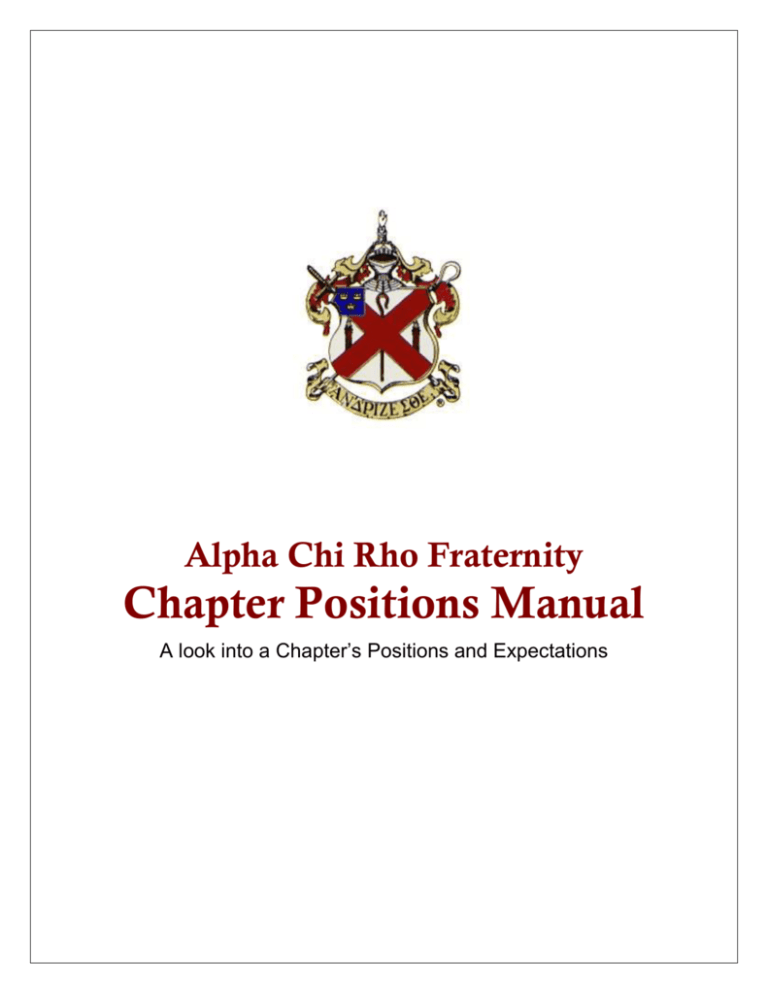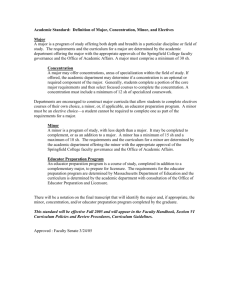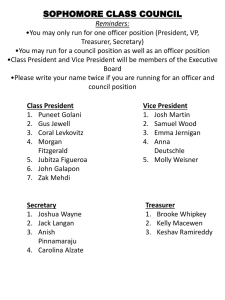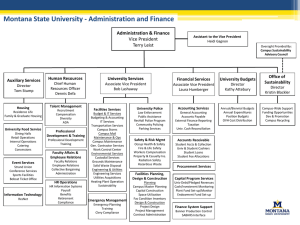Chapter Positions Manual
advertisement

Alpha Chi Rho Fraternity Chapter Positions Manual A look into a Chapter’s Positions and Expectations Structure The contents of this handbook are the result of an observation from the National staff from visits to various chapters and talks with various Brothers and Alumni who are affiliated with Alpha Chi Rho National Fraternity for the use in improving or establishing any chapters programming boards, or chairperson’s structure. It should be understood that each chapter is self-governing and solely responsible for its day-today, week-to-week and month-to-month operation and nothing herein is intended as or should be deemed as supervision, direction, monitoring, oversight or as an effort to control the local chapter by the Alpha Chi Rho National Fraternity,. This handbook is an educational guideline only which contains suggestions and recommendations developed by the National Staff which were able to develop successful programs at our various chapters throughout the country. All ideas herein are optional and nothing is mandatory. Participation is by the voluntary choice of each chapter and each member with the understanding that one generally gets out of something what one is willing to put into it. Thus, any language contained herein which could possibly be construed as “mandatory” such as “do this” or “do that” is only in the form of a recommendation that if one wishes to get the most benefit out of using the suggestions in the handbook, then the suggestions can be utilized with the understanding that any handbook is, at most, a guide and that the users should substitute their own experience and judgment to use, adapt or modify the suggestions and recommendations contained herein. In other words, the handbook is a guide from which the users can use to establish, improve or build their own programs, using their own knowledge, common sense, ideas and experience and to assist the users from time to time as a reference for ideas and suggestions Resident Chapter Duly Matriculated Graduate Brothers in good standing The Chapter consists of ... A Brother of the faculty or administration that wishes to be active in the Resident Chapter * The Graduate Advisor serves only as an advisor to the Chapter Chapter President Secretary (Recording) Vice President Executive Board Treasurer VOTING Member at Large The Council consists of at least... * The Faculty Advisor serves as an advisor to the Executive Council Postulant Educator President (except as a tie breaker) NONVOTING Risk Manager Lead by the Vice President, the E-Board Historian Chaplain House Manager Alumni Relations Sergeantat-Arms Athletics Chair Special events Public Relations Scholarship Committee Chair Community Service/ Philanthropy Fundraising Recruitment chair Campus Involvement Social Chair Original Documentation by Nate Thompson/ Revised (2011) by Ryan Barck Contents The Executive Board President...........................................................................................................5 Vice President ..................................................................................................5 Treasurer (and Finance Committee) ................................................................6 Risk Management Officer ..............................................................................7 Secretary (or “Secretary/Membership Officer”) .............................................7 Postulant Educator ...........................................................................................8 Member at Large..............................................................................................8 The Committee Chairs Recruitment Officer (or "Rush Chair")……………………………………. .9 Sergeant-at-Arms……………………………………………………………9 Ritual Chairman……………………………………………………………..9 Alumni Relations .............................................................................................9 Scholarship ....................................................................................................10 Historian.........................................................................................................10 Fundraising ....................................................................................................10 Chaplain……………………………………………………………………10 Athletics .........................................................................................................10 Social .............................................................................................................10 Public Relations .............................................................................................11 Community Service .......................................................................................11 House Manager…………………………………………………………….11 Campus Involvement .....................................................................................11 Special Events ................................................................................................11 Executive Board President Role: As the chief executive of the chapter, the president will spend most of his time and energies working toward accomplishing the chapter’s strategic goals. He will also serve as the primary chapter representative to the chapter’s alumni advisory board and university student affairs personnel. Selection: Chapter presidents are elected. Qualifications: Presidents are typically upperclassmen who have demonstrated success in other prominent chapter roles (e.g. rush chairman, treasurer or vice president). Sample Tactics: The president will typically lead the chapter in the annual goal setting retreat and in a biannual officer/chairman transition retreat. He will usually chair a weekly executive council meeting. Term: Presidents usually serve a one year term. Vice President Role: The vice president is usually charged with guiding the cabinet and committee chairmen. Selection: Vice presidents are elected. Qualifications: Vice presidential candidates typically will have held prominent committee chairmen roles (e.g. risk awareness, social or pledge education). Sample Tactics: Bi-weekly cabinet meetings are typically chaired by the vice presidents, during which progress towards goals is evaluated from each committee chairman and financial reports are reviewed. Term: Vice presidents will typically serve a one year term. Treasurer (and Finance Committee) Role: The treasurer is the chief financial officer of the chapter and is usually responsible for the overall financial health and stability of the chapter, allocating the resources necessary to accomplish the organization’s goals. In addition to being a member of the executive council, he will chair the chapter’s finance committee. The treasurer is also in charge of paying all assessments to the National Fraternity HQ. Selection: Treasurers are elected; members of the finance committee (if applicable) are typically appointed by the treasurer or executive council. Qualifications: Treasurers will typically have a good understanding of finance and/or accounting, and is usually majoring in a business-related field. Sample Tactics: The treasurer will usually provide the chapter, on a monthly basis, three financial reports: a balance sheet, a profit and loss (a.k.a. income) statement, and a cash flow analysis. These are usually distributed to every member and discussed during chapter meetings. The responsibilities of the treasurer or financial committee are as follows: Discusses financial obligations with all prospective members; collects membership contracts and, with the house manager, collects all housing contracts; coordinates collection efforts with third-party service providers (e.g. university billing department or companies such as Omega Financial, Inc.) if applicable. Balances the chapter’s checkbook; ensures that all checks require dual signatures (typically president and treasurer); reimburses committee chairmen for approved expenses. Develops and distributes the monthly financial reports to members, officers and committee chairmen. The treasurer typically leads the chapter in the development of its budget. That process usually includes the following steps: 1. Solicitation of budget requests from officers and chairmen. 2. Development of draft budgets (separate budgets for operations, housing and kitchen), taking into account the priorities established during the goal setting retreat. 3. Presentation of draft budgets to the executive council for discussion and revision if necessary. 4. Presentation of draft budgets to the chapter for ratification Term: Treasurers usually serve one-year terms. These terms are typically from January through December. Risk Management Officer Role: The risk awareness officer is typically charged with identifying risks and threats to members, guests and the overall chapter; while educating members about these risks and assisting the chapter in reducing its exposure to threats. Selection: The risk awareness officer should be elected by the chapter and serve on the chapter executive board. Qualifications: A good risk awareness officer candidate will typically be an experienced and respected member of the chapter. Sample Tactics: Usual duties include semesterly education and enforcement of the Fraternity’s Risk Management policies, FIPG, and other applicable risk awareness policies, presentation of the Fraternity’s Statement of Position on Hazing to each pledge, review of all chapter events for compliance with the chapter’s risk awareness plan, review of chapter house safety needs (usually through coordination with the house manager) and maintenance and refinement of the chapter’s crisis management plan. Term: Most risk management officers serve a one year term. Secretary (or “Secretary/Membership Officer”) Role: The secretary is usually responsible for maintaining the chapter’s roster and bylaws. The secretary is expected to report new members, initiations, and alumnus status to the Fraternity HQ. The secretary will also submit chapter updates to the editor of the Garnet and White by the appropriate deadlines. Selection: The secretary is usually elected by the chapter. Qualifications: A candidate for secretary will have typically held a committee chairmanship. This position can be a good “stepping stone” for those aspiring to hold higher chapter office. Sample Tactics: Usual duties include keeping attendance and minutes at executive and chapter meetings, maintaining the chapter’s bylaws and ensuring that proper procedures are followed for chapter elections and membership expulsions. In some situations, the secretary will chair the ‘membership development committee’ and guide their programming. Term: Secretaries are typically elected to a one year term. Postulant Educator Role: The new member educator is charged with being a teacher for the new members of the Fraternity. The new member educator is typically the main liaison between the chapter and the new member class. As new member educator, you will educate the new members’ subjects involving the Fraternity history, the Exoteric Manual, and guide them through a recommended new member program of 6 weeks or less (if applicable). The new member educator needs to stay true to what is right if members of the chapter try to influence how you educate the new members. Most importantly, the new member educator must enforce the Fraternity Policies related to hazing and enforce a zero tolerance policy towards hazing during the new member program. Selection: The new member educator should be elected by the chapter. Under certain circumstances there can be an assistant Postulant educator based on the chapter discretion. Qualifications: The new member educator should be an experienced and respected member of the chapter. Sample Tactics: The new member educator will organize a program that is six weeks or less and create a new member handbook. The new member educator needs to have consistent communication with the new members, members of the chapter, and be able to motivate the chapter to adapt a positive environment with the new member program. The new member educator will oversee the new member’s weekly meetings, their elections, and organize the new member retreat mid-way through the program. They will also organize an effective big brother program for the new members and the chapter. Term: The new member educator usually serves a one semester term. Member At Large Role: The Member at Large is in charge of being the “Brotherhood” chairperson. The Member at Large along with the Chaplain is typically a liaison between Brothers who may have problems. The Member at Large is also responsible for scheduling events that the postulants and brother partake in. They will work to schedule retreats, and chapter bonding events. Selection: The Member at Large is elected by a vote of the Chapter. Qualifications: The Member at Large is typically an easy going, easy to get along with Brother. They have a level head and good negotiation skills. Sample Tactics: The Member at Large is responsible for planning the Chapter’s annual Formal. The Member at Large is also for Chapter to Chapter relations and organizing visits to other Chapters. They will work closely with the Postulant Educator, Special Events Coordinator, and Alumni Relations Chairman to arrange events for brothers to attend and what will be required or provided at these events. They will be responsible for organizing retreats, and brother bonding activities. They Member at Large will also organize the Chapter’s “Senior Farewell” for graduating seniors. Term: The Member at Large usually serves a one year term. The Committee Chairs The Committee chairpersons are typically led by the vice president. It is typical for the vice president to lead a weekly or bi-weekly cabinet meeting to maintain communication among the committees and encourage progress toward overall goals. Recruitment Officer (or “Rush Chair”) Sample Goals Charged with recruiting new members and coordinating the work of the recruitment committee on an active and year-round basis. The recruitment officer will typically chair a weekly meeting of the recruitment committee organize all recruitment events maintain the chapter’s list of prospects (names list) Appoint members to the recruitment committee and lead the committee. Sergeant-at-Arms Sample Goals The sergeant-at-arms serves an important role during the use of the Fraternity’s Ritual. Maintains order and assists in smooth running of Chapter meetings. Discipline of chapter members is dealt with by Sergeant-at-Arms and Executive Board (or Judicial Board if applicable). Ritual Chairman Sample Goals Organizes Monthly Ritual meetings Organizes Ritual workshops Distribute Exoteric manual Supervise Exoteric and Esoteric Ritual ceremonies Alumni Relations Sample Goals Bi-weekly communication with alumni Host regular alumni events Offer opportunities for chapter and alumni interaction Alumni newsletters (chapter or third-party produced) Golf tournaments or homecoming receptions Organize an alumni advisory board with chapter advisor Scholarship Sample Goals Encourage scholastic achievement Improve the chapter’s overall grade point average Rank above the all-fraternity GPA average Scholarship competitions and awards Offer resources and advisement through university Historian Sample Goals Uncover and protect records of the chapter’s history Record contemporary activities for historical archives Chapter history archive Fundraising Sample Goals Raise funds for a special project Raise funds for a chapter house savings account Work at sporting venue of professional team, minor league team, or university team or theme park Chaplain Sample Goals Settle disputes among Brothers Run important Ritual position Athletics Sample Goals Win the all-campus intramural trophy Win the all-fraternity intramural trophy Recruit athletes for teams Schedule practices Promote athletic events/opportunities Social Sample Goals Become the socially preferred fraternity on campus Host fun, safe and unique social events Poll members for event ideas Contact sororities to market social opportunities Plan the chapter’s social calendar Public Relations Sample Goals Promote a positive chapter image to external constituents Press releases Written PR program Thank you notes Maintain professional website Community Service Sample Goals Increase chapter community service participation Host a signature “Challenge the World” event on campus and in the community Host a signature philanthropy event on campus and in the community House Manager Sample Goal Improve/maintain the condition of the chapter house Live-in housing contracts Cleaning schedules Market rental rates Campus Involvement Sample Goals Increase member participation and leadership in campus organizations Increase chapter representation in prestigious campus organizations Educate chapter members on campus organizations (speakers, profiles, etc.) Recruit members to join campus organizations Encourage chapter participation in campus elections Special Events Sample Goals Host a campus speaker Plan Homecoming celebration Plan a Founders Day event Host a Parents Weekend Organize special events committee Coordinate funding with fundraising committee







